CADILLAC XLR 2009 1.G Manual Online
Manufacturer: CADILLAC, Model Year: 2009, Model line: XLR, Model: CADILLAC XLR 2009 1.GPages: 462, PDF Size: 3.72 MB
Page 81 of 462
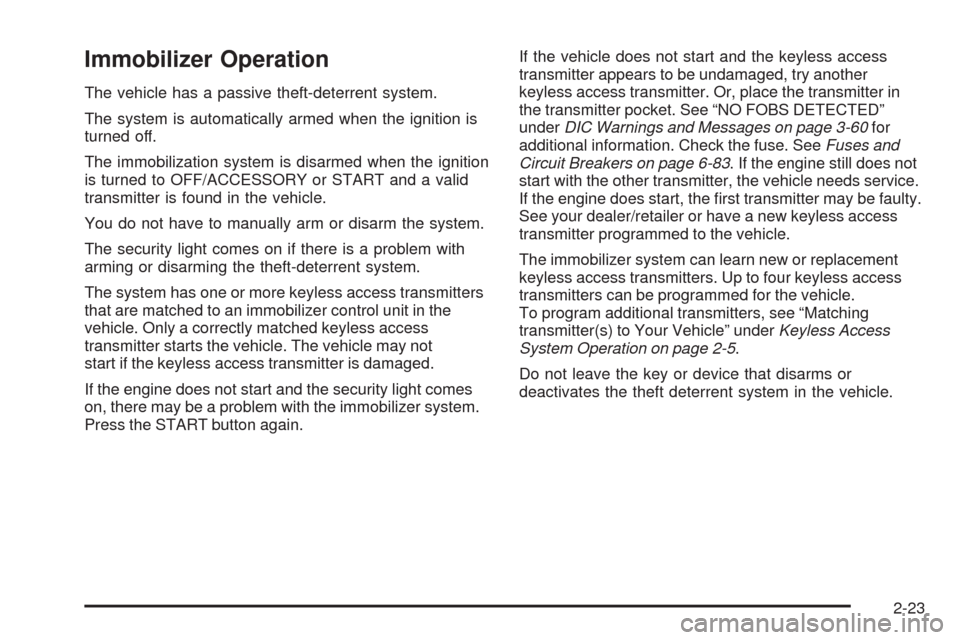
Immobilizer Operation
The vehicle has a passive theft-deterrent system.
The system is automatically armed when the ignition is
turned off.
The immobilization system is disarmed when the ignition
is turned to OFF/ACCESSORY or START and a valid
transmitter is found in the vehicle.
You do not have to manually arm or disarm the system.
The security light comes on if there is a problem with
arming or disarming the theft-deterrent system.
The system has one or more keyless access transmitters
that are matched to an immobilizer control unit in the
vehicle. Only a correctly matched keyless access
transmitter starts the vehicle. The vehicle may not
start if the keyless access transmitter is damaged.
If the engine does not start and the security light comes
on, there may be a problem with the immobilizer system.
Press the START button again.If the vehicle does not start and the keyless access
transmitter appears to be undamaged, try another
keyless access transmitter. Or, place the transmitter in
the transmitter pocket. See “NO FOBS DETECTED”
underDIC Warnings and Messages on page 3-60for
additional information. Check the fuse. SeeFuses and
Circuit Breakers on page 6-83. If the engine still does not
start with the other transmitter, the vehicle needs service.
If the engine does start, the �rst transmitter may be faulty.
See your dealer/retailer or have a new keyless access
transmitter programmed to the vehicle.
The immobilizer system can learn new or replacement
keyless access transmitters. Up to four keyless access
transmitters can be programmed for the vehicle.
To program additional transmitters, see “Matching
transmitter(s) to Your Vehicle” underKeyless Access
System Operation on page 2-5.
Do not leave the key or device that disarms or
deactivates the theft deterrent system in the vehicle.
2-23
Page 82 of 462
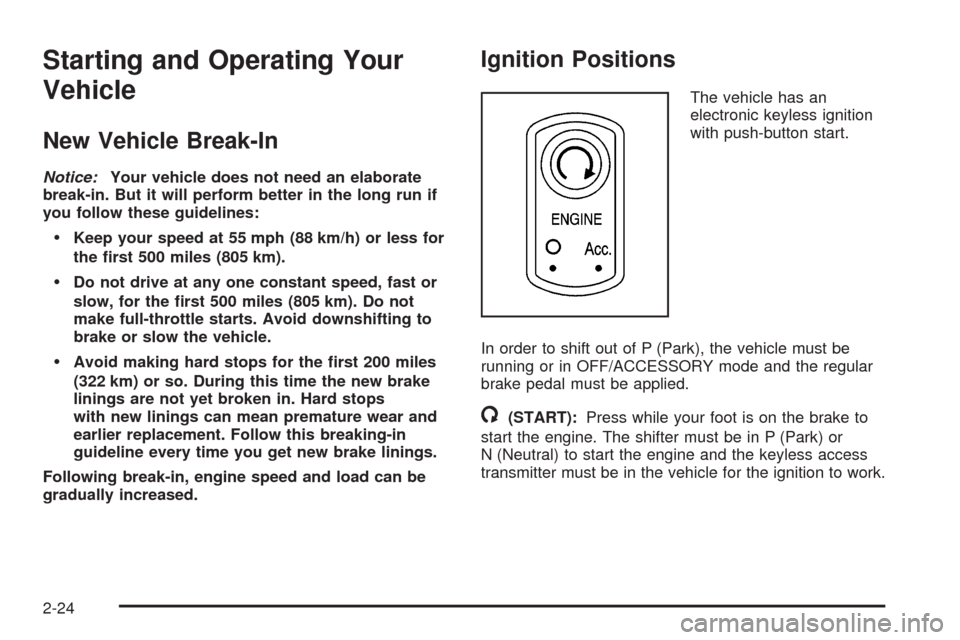
Starting and Operating Your
Vehicle
New Vehicle Break-In
Notice:Your vehicle does not need an elaborate
break-in. But it will perform better in the long run if
you follow these guidelines:
Keep your speed at 55 mph (88 km/h) or less for
the �rst 500 miles (805 km).
Do not drive at any one constant speed, fast or
slow, for the �rst 500 miles (805 km). Do not
make full-throttle starts. Avoid downshifting to
brake or slow the vehicle.
Avoid making hard stops for the �rst 200 miles
(322 km) or so. During this time the new brake
linings are not yet broken in. Hard stops
with new linings can mean premature wear and
earlier replacement. Follow this breaking-in
guideline every time you get new brake linings.
Following break-in, engine speed and load can be
gradually increased.
Ignition Positions
The vehicle has an
electronic keyless ignition
with push-button start.
In order to shift out of P (Park), the vehicle must be
running or in OFF/ACCESSORY mode and the regular
brake pedal must be applied.
/(START):Press while your foot is on the brake to
start the engine. The shifter must be in P (Park) or
N (Neutral) to start the engine and the keyless access
transmitter must be in the vehicle for the ignition to work.
2-24
Page 83 of 462

9Acc. (OFF/ACCESSORY):When this button is
pressed, the engine will turn off even if the shifter is not
in P (Park). If the shifter is in P (Park), the ignition
mode will change to Retained Accessory Power (RAP),
if all doors are closed. The ignition mode will change
to off, if a front door is opened. SeeRetained Accessory
Power (RAP) on page 2-25for more information.
If the shifter is not in P (Park), the ignition mode will
change to Acc. SeeShifting Into Park on page 2-33.
When the engine is off, press this button to place the
vehicle in accessory mode. ACCESSORY MODE ON will
display on the Driver Information Center (DIC). This mode
allows you to use things like the radio and the windshield
wipers while the engine is off. Use accessory mode if you
must have the vehicle in motion while the engine is off, for
example, if the vehicle is being towed. If the door is open
while in accessory mode, the key in reminder chime will
sound continuously.If the push-button start is not working, the vehicle may be
near a strong radio antenna signal causing interference to
the keyless access system. SeeDIC Warnings and
Messages on page 3-60for more information.
After being in ACCESSORY mode for about 20 minutes,
the vehicle will automatically enter RAP or will turn off,
depending on if the doors are opened or closed.
Retained Accessory Power (RAP)
Power to the following accessories continues to work for
up to 10 minutes after the engine is turned off or until
a door is opened:
Audio System
Audio Steering Wheel Controls
Power Windows
For an additional 10 minutes of operation, close all the
doors and press the Acc. button to place the vehicle in
accessory mode. Press the button again to return to RAP.
2-25
Page 84 of 462
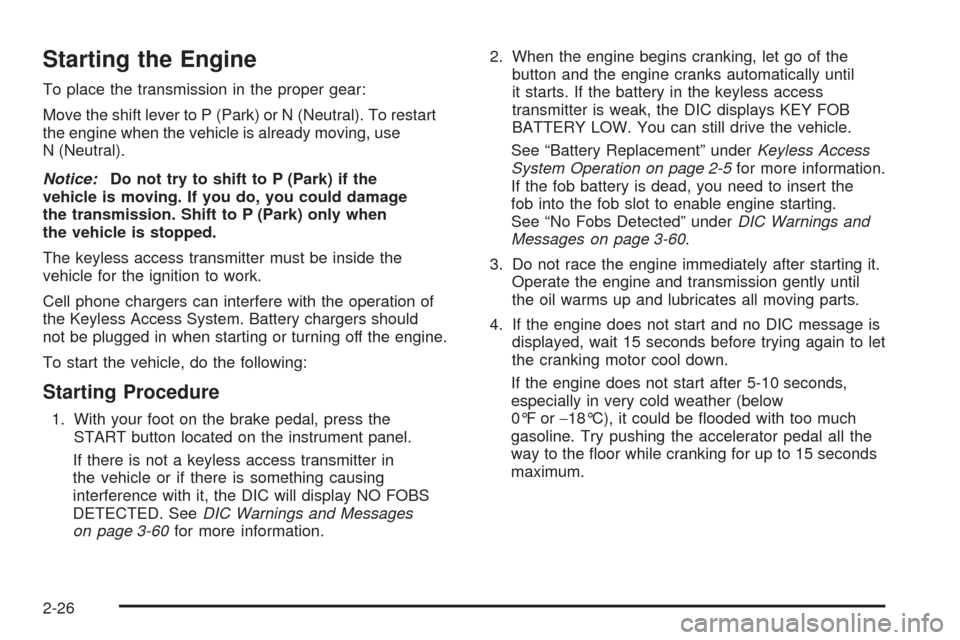
Starting the Engine
To place the transmission in the proper gear:
Move the shift lever to P (Park) or N (Neutral). To restart
the engine when the vehicle is already moving, use
N (Neutral).
Notice:Do not try to shift to P (Park) if the
vehicle is moving. If you do, you could damage
the transmission. Shift to P (Park) only when
the vehicle is stopped.
The keyless access transmitter must be inside the
vehicle for the ignition to work.
Cell phone chargers can interfere with the operation of
the Keyless Access System. Battery chargers should
not be plugged in when starting or turning off the engine.
To start the vehicle, do the following:
Starting Procedure
1. With your foot on the brake pedal, press the
START button located on the instrument panel.
If there is not a keyless access transmitter in
the vehicle or if there is something causing
interference with it, the DIC will display NO FOBS
DETECTED. SeeDIC Warnings and Messages
on page 3-60for more information.2. When the engine begins cranking, let go of the
button and the engine cranks automatically until
it starts. If the battery in the keyless access
transmitter is weak, the DIC displays KEY FOB
BATTERY LOW. You can still drive the vehicle.
See “Battery Replacement” underKeyless Access
System Operation on page 2-5for more information.
If the fob battery is dead, you need to insert the
fob into the fob slot to enable engine starting.
See “No Fobs Detected” underDIC Warnings and
Messages on page 3-60.
3. Do not race the engine immediately after starting it.
Operate the engine and transmission gently until
the oil warms up and lubricates all moving parts.
4. If the engine does not start and no DIC message is
displayed, wait 15 seconds before trying again to let
the cranking motor cool down.
If the engine does not start after 5-10 seconds,
especially in very cold weather (below
0°F or−18°C), it could be �ooded with too much
gasoline. Try pushing the accelerator pedal all the
way to the �oor while cranking for up to 15 seconds
maximum.
2-26
Page 85 of 462
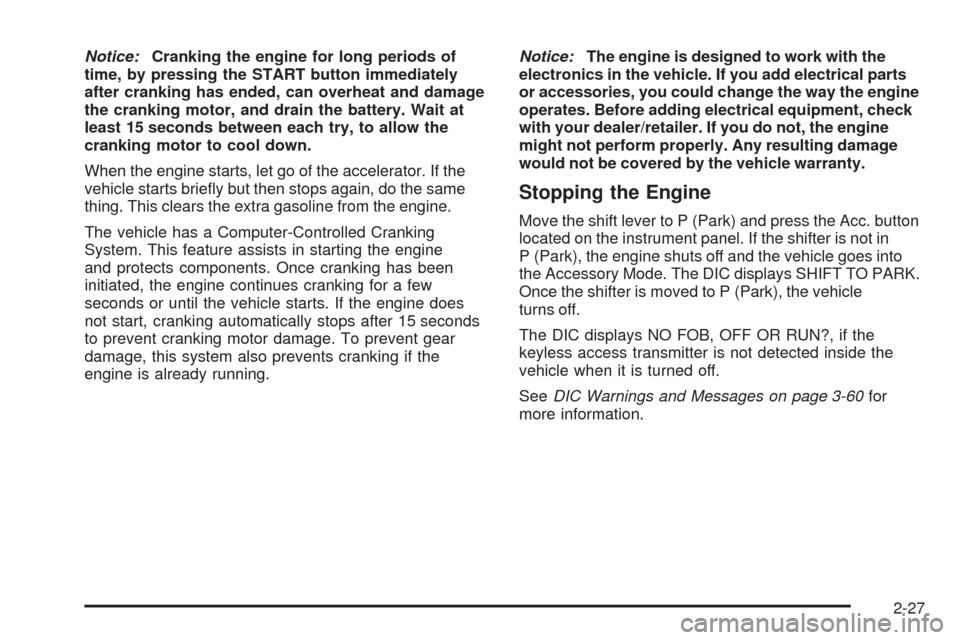
Notice:Cranking the engine for long periods of
time, by pressing the START button immediately
after cranking has ended, can overheat and damage
the cranking motor, and drain the battery. Wait at
least 15 seconds between each try, to allow the
cranking motor to cool down.
When the engine starts, let go of the accelerator. If the
vehicle starts brie�y but then stops again, do the same
thing. This clears the extra gasoline from the engine.
The vehicle has a Computer-Controlled Cranking
System. This feature assists in starting the engine
and protects components. Once cranking has been
initiated, the engine continues cranking for a few
seconds or until the vehicle starts. If the engine does
not start, cranking automatically stops after 15 seconds
to prevent cranking motor damage. To prevent gear
damage, this system also prevents cranking if the
engine is already running.Notice:The engine is designed to work with the
electronics in the vehicle. If you add electrical parts
or accessories, you could change the way the engine
operates. Before adding electrical equipment, check
with your dealer/retailer. If you do not, the engine
might not perform properly. Any resulting damage
would not be covered by the vehicle warranty.
Stopping the Engine
Move the shift lever to P (Park) and press the Acc. button
located on the instrument panel. If the shifter is not in
P (Park), the engine shuts off and the vehicle goes into
the Accessory Mode. The DIC displays SHIFT TO PARK.
Once the shifter is moved to P (Park), the vehicle
turns off.
The DIC displays NO FOB, OFF OR RUN?, if the
keyless access transmitter is not detected inside the
vehicle when it is turned off.
SeeDIC Warnings and Messages on page 3-60for
more information.
2-27
Page 86 of 462
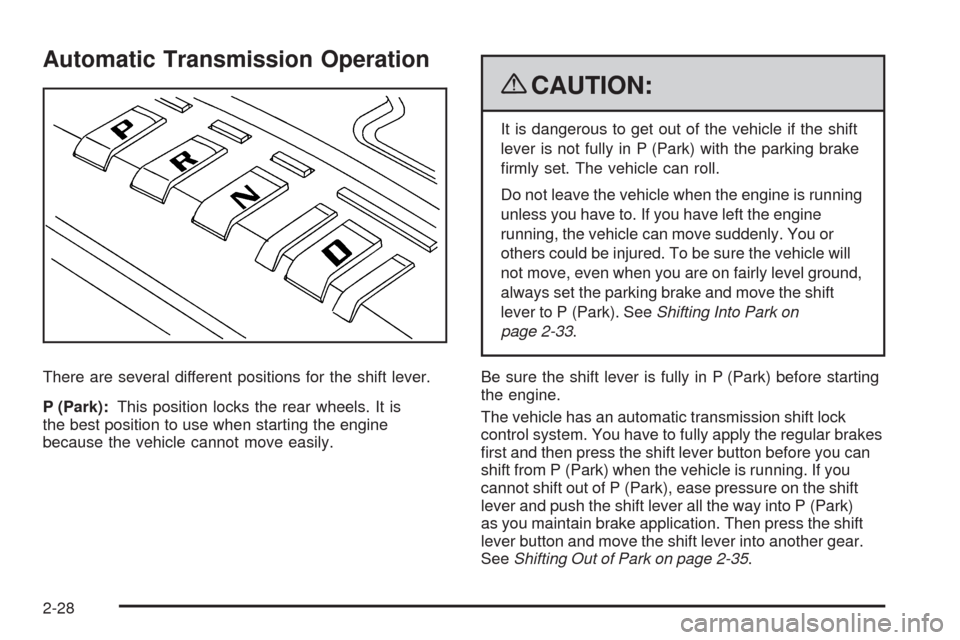
Automatic Transmission Operation
There are several different positions for the shift lever.
P (Park):This position locks the rear wheels. It is
the best position to use when starting the engine
because the vehicle cannot move easily.
{CAUTION:
It is dangerous to get out of the vehicle if the shift
lever is not fully in P (Park) with the parking brake
�rmly set. The vehicle can roll.
Do not leave the vehicle when the engine is running
unless you have to. If you have left the engine
running, the vehicle can move suddenly. You or
others could be injured. To be sure the vehicle will
not move, even when you are on fairly level ground,
always set the parking brake and move the shift
lever to P (Park). SeeShifting Into Park on
page 2-33.
Be sure the shift lever is fully in P (Park) before starting
the engine.
The vehicle has an automatic transmission shift lock
control system. You have to fully apply the regular brakes
�rst and then press the shift lever button before you can
shift from P (Park) when the vehicle is running. If you
cannot shift out of P (Park), ease pressure on the shift
lever and push the shift lever all the way into P (Park)
as you maintain brake application. Then press the shift
lever button and move the shift lever into another gear.
SeeShifting Out of Park on page 2-35.
2-28
Page 87 of 462
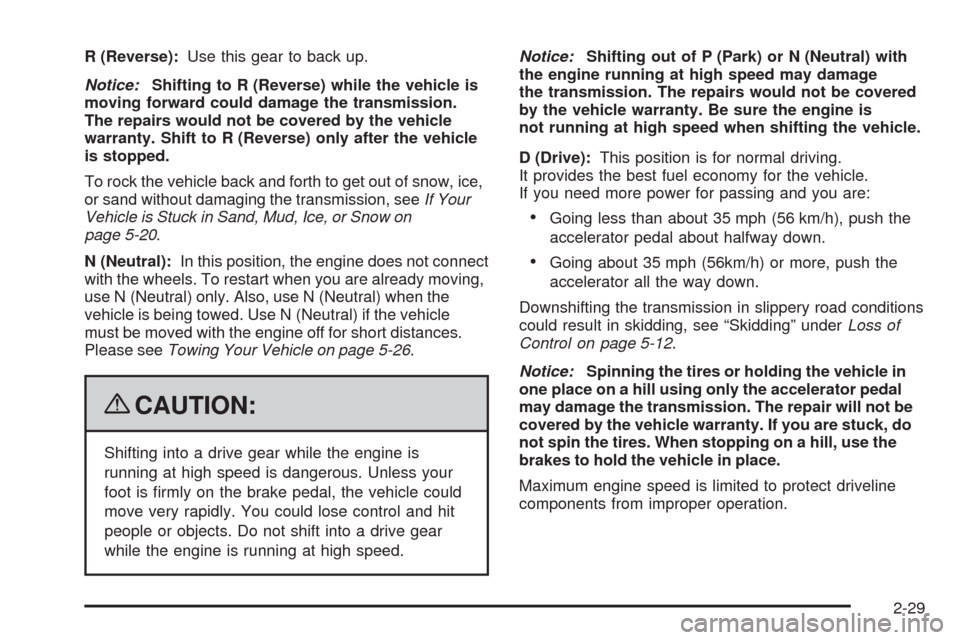
R (Reverse):Use this gear to back up.
Notice:Shifting to R (Reverse) while the vehicle is
moving forward could damage the transmission.
The repairs would not be covered by the vehicle
warranty. Shift to R (Reverse) only after the vehicle
is stopped.
To rock the vehicle back and forth to get out of snow, ice,
or sand without damaging the transmission, seeIf Your
Vehicle is Stuck in Sand, Mud, Ice, or Snow on
page 5-20.
N (Neutral):In this position, the engine does not connect
with the wheels. To restart when you are already moving,
use N (Neutral) only. Also, use N (Neutral) when the
vehicle is being towed. Use N (Neutral) if the vehicle
must be moved with the engine off for short distances.
Please seeTowing Your Vehicle on page 5-26.
{CAUTION:
Shifting into a drive gear while the engine is
running at high speed is dangerous. Unless your
foot is �rmly on the brake pedal, the vehicle could
move very rapidly. You could lose control and hit
people or objects. Do not shift into a drive gear
while the engine is running at high speed.Notice:Shifting out of P (Park) or N (Neutral) with
the engine running at high speed may damage
the transmission. The repairs would not be covered
by the vehicle warranty. Be sure the engine is
not running at high speed when shifting the vehicle.
D (Drive):This position is for normal driving.
It provides the best fuel economy for the vehicle.
If you need more power for passing and you are:
Going less than about 35 mph (56 km/h), push the
accelerator pedal about halfway down.
Going about 35 mph (56km/h) or more, push the
accelerator all the way down.
Downshifting the transmission in slippery road conditions
could result in skidding, see “Skidding” underLoss of
Control on page 5-12.
Notice:Spinning the tires or holding the vehicle in
one place on a hill using only the accelerator pedal
may damage the transmission. The repair will not be
covered by the vehicle warranty. If you are stuck, do
not spin the tires. When stopping on a hill, use the
brakes to hold the vehicle in place.
Maximum engine speed is limited to protect driveline
components from improper operation.
2-29
Page 88 of 462
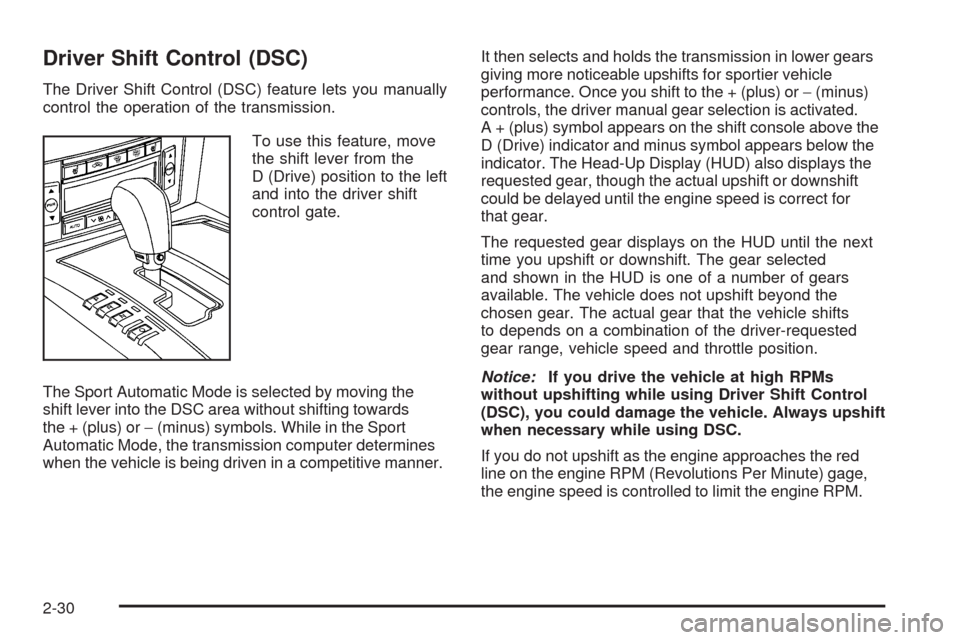
Driver Shift Control (DSC)
The Driver Shift Control (DSC) feature lets you manually
control the operation of the transmission.
To use this feature, move
the shift lever from the
D (Drive) position to the left
and into the driver shift
control gate.
The Sport Automatic Mode is selected by moving the
shift lever into the DSC area without shifting towards
the + (plus) or−(minus) symbols. While in the Sport
Automatic Mode, the transmission computer determines
when the vehicle is being driven in a competitive manner.It then selects and holds the transmission in lower gears
giving more noticeable upshifts for sportier vehicle
performance. Once you shift to the + (plus) or−(minus)
controls, the driver manual gear selection is activated.
A + (plus) symbol appears on the shift console above the
D (Drive) indicator and minus symbol appears below the
indicator. The Head-Up Display (HUD) also displays the
requested gear, though the actual upshift or downshift
could be delayed until the engine speed is correct for
that gear.
The requested gear displays on the HUD until the next
time you upshift or downshift. The gear selected
and shown in the HUD is one of a number of gears
available. The vehicle does not upshift beyond the
chosen gear. The actual gear that the vehicle shifts
to depends on a combination of the driver-requested
gear range, vehicle speed and throttle position.
Notice:If you drive the vehicle at high RPMs
without upshifting while using Driver Shift Control
(DSC), you could damage the vehicle. Always upshift
when necessary while using DSC.
If you do not upshift as the engine approaches the red
line on the engine RPM (Revolutions Per Minute) gage,
the engine speed is controlled to limit the engine RPM.
2-30
Page 89 of 462
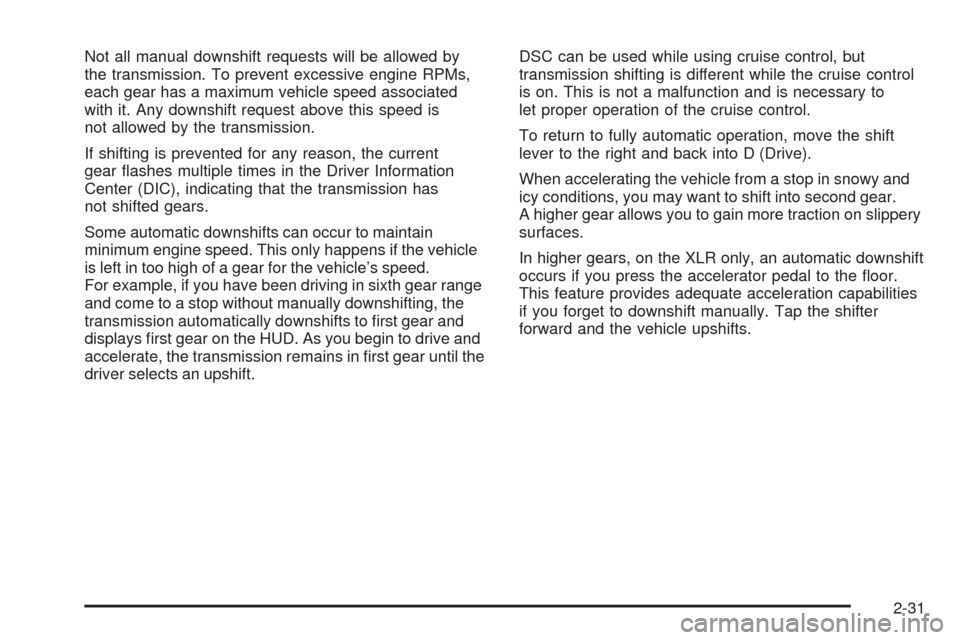
Not all manual downshift requests will be allowed by
the transmission. To prevent excessive engine RPMs,
each gear has a maximum vehicle speed associated
with it. Any downshift request above this speed is
not allowed by the transmission.
If shifting is prevented for any reason, the current
gear �ashes multiple times in the Driver Information
Center (DIC), indicating that the transmission has
not shifted gears.
Some automatic downshifts can occur to maintain
minimum engine speed. This only happens if the vehicle
is left in too high of a gear for the vehicle’s speed.
For example, if you have been driving in sixth gear range
and come to a stop without manually downshifting, the
transmission automatically downshifts to �rst gear and
displays �rst gear on the HUD. As you begin to drive and
accelerate, the transmission remains in �rst gear until the
driver selects an upshift.DSC can be used while using cruise control, but
transmission shifting is different while the cruise control
is on. This is not a malfunction and is necessary to
let proper operation of the cruise control.
To return to fully automatic operation, move the shift
lever to the right and back into D (Drive).
When accelerating the vehicle from a stop in snowy and
icy conditions, you may want to shift into second gear.
A higher gear allows you to gain more traction on slippery
surfaces.
In higher gears, on the XLR only, an automatic downshift
occurs if you press the accelerator pedal to the �oor.
This feature provides adequate acceleration capabilities
if you forget to downshift manually. Tap the shifter
forward and the vehicle upshifts.
2-31
Page 90 of 462
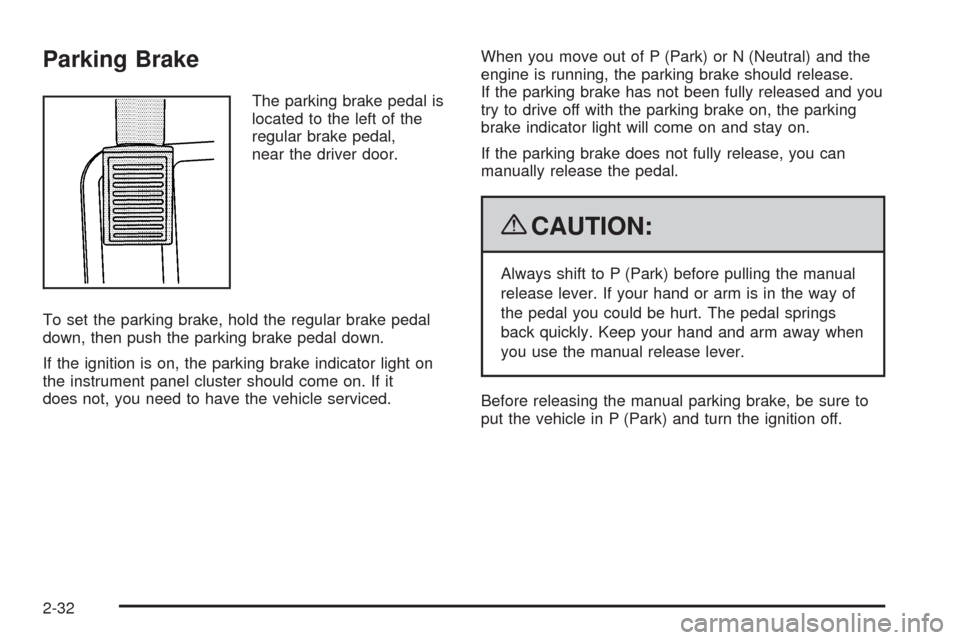
Parking Brake
The parking brake pedal is
located to the left of the
regular brake pedal,
near the driver door.
To set the parking brake, hold the regular brake pedal
down, then push the parking brake pedal down.
If the ignition is on, the parking brake indicator light on
the instrument panel cluster should come on. If it
does not, you need to have the vehicle serviced.When you move out of P (Park) or N (Neutral) and the
engine is running, the parking brake should release.
If the parking brake has not been fully released and you
try to drive off with the parking brake on, the parking
brake indicator light will come on and stay on.
If the parking brake does not fully release, you can
manually release the pedal.
{CAUTION:
Always shift to P (Park) before pulling the manual
release lever. If your hand or arm is in the way of
the pedal you could be hurt. The pedal springs
back quickly. Keep your hand and arm away when
you use the manual release lever.
Before releasing the manual parking brake, be sure to
put the vehicle in P (Park) and turn the ignition off.
2-32